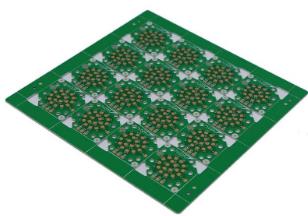PCB copy board design and manufacturing is moving from subtractive method to additive method. This article mainly elaborates the related concepts and manufacturing process of PCB subtractive method and additive method for your reference and learning!
1. Introduction to PCB Subtractive Process
The subtractive process is a method of selectively removing part of the copper foil on the surface of the copper-clad laminate to obtain a conductive pattern. The subtractive method is the main method of today's printed circuit manufacturing. Its biggest advantage is that the process is mature, stable and reliable.
Printed circuits manufactured by subtractive technology can be divided into the following two categories.
1. Non-porous printed circuit board (. Non-plating-thr’ough-hole Board)
This type of printed board is produced by screen printing and then etched out of the printed board, or it can be produced by photochemical method. Non-perforated plated printed boards are mainly single-sided boards, but also a few double-sided boards, which are mainly used for televisions and radios. The following is the single-sided production process:
Single-sided copper-clad board: unloading-photochemical method/screen printing image transfer-removing resist printing-cleaning and drying-hole processing-shape processing-cleaning and drying-printing solder mask coating-curing-printing marking symbol- Curing-cleaning and drying-pre-coating flux-drying-finished product.

2. Plating-through-hole Board
On the copper clad laminates that have been drilled, electroless plating and electroplating are used to electrically insulate the pores between two or more conductive patterns into electrical connections. This type of printed board is called perforated plating. Printed board. Perforated plated printed boards are mainly used in computers, program-controlled switches, mobile phones, etc. According to the different electroplating methods, it is divided into pattern electroplating and full plate electroplating.
(1) Pattern plating (Patter.n, P'I'N) On double-sided copper clad laminates, conductive patterns are formed by screen printing or photochemical methods, and lead-tin, tin-cerium are plated on the conductive patterns, Tin-nickel or gold and other anti-corrosive metals, and then remove the resist other than the circuit pattern, and then be formed by etching. The pattern plating method is divided into pattern plating and etching process (Pattern PlATIng And Etching Process) and bare copper covered solder mask process (Solder Mask OnBare Copper, SMOBC). The process of making double-sided printed boards with bare copper-clad solder mask process is as follows.
Double-sided copper clad laminates are blanked, positioning holes, CNC drilling, inspection, hair removal, electroless thin copper plating, thin copper electroplating, inspection, brushing, filming (or screen printing), exposure and development (or curing), Inspection and revision-pattern copper plating-pattern tin-lead alloy electroplating-film removal (or removal of printing material)-inspection and revision-etching-lead back tin-on and off test-cleaning-solder mask pattern-plug nickel/gold plating-plug sticker Adhesive tape-hot air leveling-cleaning-screen printing marking symbols-shape processing-cleaning and drying-inspection-packaging-finished product.
(2) Full board electroplating (Panel, PNL) on double-sided copper clad laminates, electroplating
Copper to a specified thickness, and then screen printing or photochemical method for image transfer to obtain a corrosion-resistant positive-phase circuit image, after etching and then remove the resist to make a printed board.
The whole plate electroplating method can be subdivided into hole plugging method and masking method. The process flow of making double-sided printed boards with the masking method (TenTIng) is as follows.
Double-sided copper clad laminates are cut, drilled, L, metalized, full-board plating, thickened, surface treatment, pasted, photomasked, dry film, positive-phase wire pattern, etched, removed, plug plating, shape Processing-inspection-printing of solder mask-solder coating hot-air leveling-printing of marking symbols-finished products.
The advantages of the above method are simple process and good uniformity of coating thickness. The disadvantage is that energy is wasted, and it is difficult to manufacture through-hole printed boards without connecting plates.
Two, PCB additive method process introduction
The method of selectively depositing conductive metal on the surface of an insulating substrate to form a conductive pattern is called an additive method.
1. Advantages of the additive method
The printed board is manufactured by the additive process, and its advantages are as follows:
(1) Because the additive method avoids a large amount of etching of copper, and the resulting large amount of etching solution processing costs, the production cost of the printed board is greatly reduced.
(2) The additive process is reduced by about 1/3 compared with the subtractive process, which simplifies the production process and improves the production efficiency. In particular, it avoids the vicious circle that the higher the product grade, the more complicated the process.
(3) The additive process can achieve flush wires and flush surfaces, so that SMT and other high-precision printed boards can be manufactured.
(4) In the additive process, due to the simultaneous electroless copper plating of the hole wall and the wire, the thickness of the copper plating layer of the conductive pattern on the hole wall and the board surface is uniform, which improves the reliability of the metallized hole and can also meet the requirements of high thickness Diameter ratio printed boards, copper plating requirements in small holes.
2. Classification of additive methods
The additive manufacturing process of PCB printed boards can be divided into the following three categories:
(1) Full Additive Process (Full Additive Process) is an additive process that only uses electroless copper to form conductive patterns. Take the CC-4 method as an example: drilling, imaging, viscosity-increasing treatment (negative phase), electroless copper plating, and resist removal. The process uses a catalytic laminate as the substrate.
(2) Semi-additive process (Semi-additive Process) On the surface of the insulating substrate, the metal is chemically deposited, combined with electroplating and etching, or the three are combined with an additive process to form conductive patterns. The process flow is: drilling, catalytic treatment and viscosity increasing treatment, electroless copper plating, imaging (electroplating resist), patterned copper electroplating (negative phase), resist removal, and differential etching. The substrate used in the manufacture is a common laminate.
(3) The Partial Additive Process of the PCB factory uses the additive method to manufacture printed boards on the catalytic copper clad laminate. Process flow: imaging (anti-etching), etching copper (normal phase), removing the resist layer, coating the entire plate with electroplating resist, drilling a hole, electroless copper plating in the hole, and removing the electroplating resist.